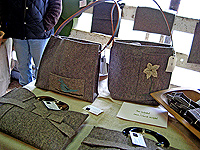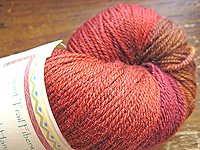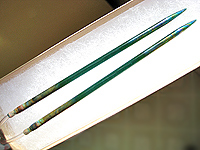Five Festival Finds
The New York State Sheep and Wool Festival, lovingly dubbed "Rhinebeck," is among the most extraordinary fiber festivals in North America.
The event takes place every October at the Dutchess County Fairgrounds in Rhinebeck, New York, which is a lovely little town just up the Hudson River from New York City. Picture sheep, fleece, yarn, and handknits galore set against a bucolic backdrop of bright fall colors, tart apple cider, and freshly carved pumpkins.
I've written a lot about previous years' festivals, but this year's Rhinebeck was different. I was there to launch my new book, The Knitter's Book of Wool, and had just a few minutes each day to explore the fairgrounds, visit some of my favorite vendors, and scope out new finds.
While this tight schedule put me at a distinct disadvantage in terms of reporting fully on the festival itself, I was still able to scope out five particularly special products this year. Since I greeted everybody with the question, "Ooooh, what's in your bag?" it's only fair that I pause and show you what was in my bag at the end of this year's show.
HilbrandtFirst, the bag itself. Competition for vendor space at Rhinebeck is extremely tight. In fact, rumor had it that the festival organizers only brought in two new vendors this year. Julia Hilbrandt was one of them.
Armed with good scissors, a sewing machine, colorful thread, and an instinctive eye for shapes, Julia transforms sheets of plush grey felt into lovely yet functional one-of-a-kind bags.
Created in various shapes and sizes, each bag has its own unique ornamentation. The shoulder bags and totes also feature a simple yet perfectly functional thick leather strap that's reinforced with a leather patch on the inside of the bag. I was excited to see a vendor combine such sophistication and functionality with wool, and I hope Julia returns next year.
RedMaple Sportswear Co.As knitters, we don't always pay close attention to those vendors offering machine-knit products at fiber festivals. RedMaple is an example of why we should.
Two years ago at this same festival I snagged a pair of RedMaple socks. Sure, they were machine-knit. But they contained a blend of alpaca, cotton, and copper. I was incredulous about that last part because my hands and eyes couldn't detect anything "coppery."
I also read about how the copper fibers were supposed to reflect heat and that they'd help relieve symptoms of stress. I was a skeptic. But two years and countless washings and wearings later, that same pair of socks has become one of my favorites. Which is a long way of explaining why RedMaple was at the top of my list of vendors to re-visit this year. If you like SmartWool and are open to adventure, check out RedMaple.
Buffalo Gold
On Saturday, I found myself out and about without any hand coverings as the temperatures dropped from chilly to frigid. Out of knitterly pride, I couldn't bring myself to buy anyone else's handknit mittens—but something had to be done because my hands were starting to go numb and I had a book signing in a few short hours.
That's when I stumbled upon Ron Miskin tucked at the end of the Still River Mill booth with a table of the Buffalo Gold mitts, mittens, hats, and socks that he's manufacturing in the U.S. from 100% bison down. Ron graciously gave me a pair of mitts, my hands were rescued, and now I know what I'm getting a lot of people for Christmas this year. The hat and gloves are also a recent smash hit in the Orvis catalog.
Spirit Trail Fiberworks
There was a lot of yarn at this show. A stupendous amount. Yarn overflowed from every bin and bucket. It was suspended from hooks and poles, bursting out into the aisles, falling off shelves, and doing everything but tiptoe back to your car and hop in the passenger's seat while you weren't looking.
A natural response to this overwhelm is what I call "yarn blindness," and it happens at every show—but especially Rhinebeck. There is so much gorgeous yarn all around that you slowly stop seeing it.
Which may explain how I left the show with only one skein of yarn in my bag: Sunna, from Spirit Trail Fiberworks. I spotted it early on before the yarn blindness had a chance to set in. And I spotted it so early because I hitched a ride into the fairgrounds with Jennifer Heverly, the woman behind Spirit Trail.
Sunna is her newest yarn, named after the Scandinavian goddess of spinning and the sun. It contains a blend of 75% superwash Merino and 15% cashmere, along with—and here's the kicker—bombyx silk. I haven't seen this particular combination in a sock yarn yet, and Jennifer went straight to the mill to make it. (Do note that this new yarn isn't up on her site yet, so please be patient.)
The silk gives the yarn a surprise hint of sheen while still adding strength to the total mix. And on a broader scale, this yarn represents what's possible when hand-dyers take their business to the next level by working directly with a mill to create something truly special just for them. I get excited thinking about what would happen if more folks took the plunge. Anyone up for it?
Michael and Sheila Ernst
Sunday was spent in the author's area, ending with only 15 minutes to spare. My mind raced. What could I do, who could I see, that would give me a sense of having fully experienced the festival? What could I bring home that would truly be special and help me fulfill my creative ambitions for the coming year?
Glass knitting needles, that's what. Sheila and Michael Ernst, the folks who have mastered the glass knitting needle better than anyone else, traveled all the way from Oregon to be at the show. I ran over to their booth and spent my last 15 minutes choosing my pair.
These are not molded or machined needles, they are entirely formed by hand out of the same material we commonly know as Pyrex. Which means that although they're glass, which is innately more fragile than metal or comparably sized wood, they're still durable. Apparently the key to their longevity is to keep a loose tension as you knit with them. I look forward to choosing a special project that I can slowly and lovingly knit throughout the winter months ahead.






